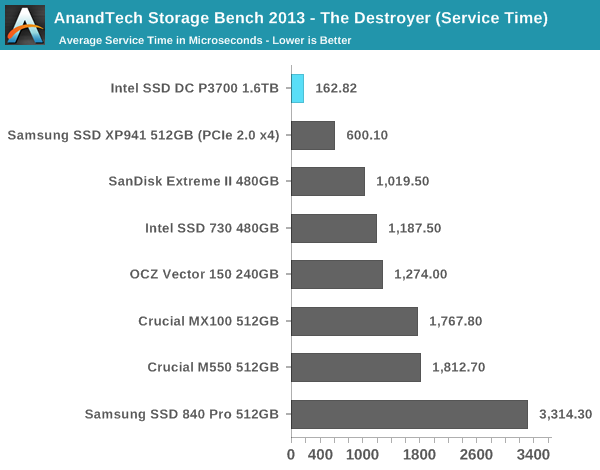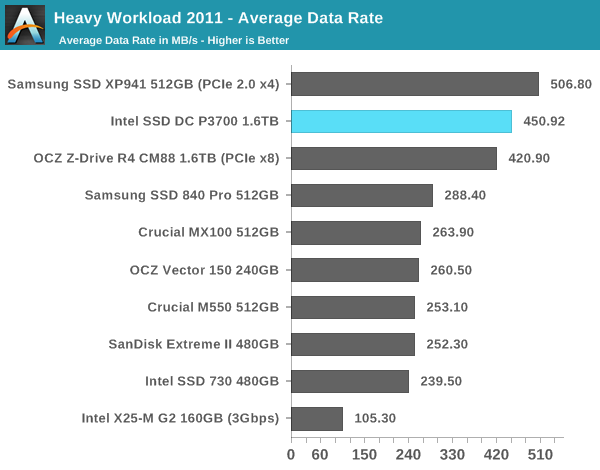The Intel SSD DC P3700 Review Part 2: NVMe on Client Workloads
by Anand Lal Shimpi on June 10, 2014 12:07 AM EST- Posted in
- Storage
- SSDs
- Intel
- Intel SSD DC P3700
- NVMe
AnandTech Storage Bench 2013
Our Storage Bench 2013 focuses on worst-case multitasking and IO consistency. Similar to our earlier Storage Benches, the test is still application trace based—we record all IO requests made to a test system and play them back on the drive we're testing and run statistical analysis on the drive's responses. There are 49.8 million IO operations in total with 1583.0GB of reads and 875.6GB of writes. I'm not including the full description of the test for better readability, so make sure to read our Storage Bench 2013 introduction for the full details.
| AnandTech Storage Bench 2013 - The Destroyer | ||
| Workload | Description | Applications Used |
| Photo Sync/Editing | Import images, edit, export | Adobe Photoshop CS6, Adobe Lightroom 4, Dropbox |
| Gaming | Download/install games, play games | Steam, Deus Ex, Skyrim, Starcraft 2, BioShock Infinite |
| Virtualization | Run/manage VM, use general apps inside VM | VirtualBox |
| General Productivity | Browse the web, manage local email, copy files, encrypt/decrypt files, backup system, download content, virus/malware scan | Chrome, IE10, Outlook, Windows 8, AxCrypt, uTorrent, AdAware |
| Video Playback | Copy and watch movies | Windows 8 |
| Application Development | Compile projects, check out code, download code samples | Visual Studio 2012 |
We are reporting two primary metrics with the Destroyer: average data rate in MB/s and average service time in microseconds. The former gives you an idea of the throughput of the drive during the time that it was running the test workload. This can be a very good indication of overall performance. What average data rate doesn't do a good job of is taking into account response time of very bursty (read: high queue depth) IO. By reporting average service time we heavily weigh latency for queued IOs. You'll note that this is a metric we've been reporting in our enterprise benchmarks for a while now. With the client tests maturing, the time was right for a little convergence.

The P3700 takes the performance crown away from Samsung's XP941. Granted we are talking about a much larger and more expensive drive, but if you're after the absolute best performance for a workstation or high-end client, the P3700 is without equal.

In our initial P3700 review we talked about the impact of NVMe and a lower overhead interface stack on IO latency - we see the benefits of that here in our look at average service times.
AnandTech Storage Bench 2011
Back in 2011 (which seems like so long ago now!), we introduced our AnandTech Storage Bench, a suite of benchmarks that took traces of real OS/application usage and played them back in a repeatable manner. The MOASB, officially called AnandTech Storage Bench 2011 - Heavy Workload, mainly focuses on peak IO performance and basic garbage collection routines. There is a lot of downloading and application installing that happens during the course of this test. Our thinking was that it's during application installs, file copies, downloading and multitasking with all of this that you can really notice performance differences between drives. The full description of the Heavy test can be found here, while the Light workload details are here.

The XP941 remains the king in our 2011 heavy test. I was pretty surprised to find the P3700 lose its first place position here, but it's still competitive.

The situation reverses back to normal when we look at the light workload.










36 Comments
View All Comments
TelstarTOS - Tuesday, June 10, 2014 - link
+1TelstarTOS - Tuesday, June 10, 2014 - link
YES! Thank you for doing these further tests :)aperson2437 - Tuesday, June 10, 2014 - link
If I had money burning a hole in my pocket and there were computers available that could support these new SSDs I'd be buying one as soon as possible ... especially the P3700. Love those endurance numbers as much as the speed benchmarks. I can't wait until there is intense competition for these NVMe drives and the prices for 500 GB+ 3700s become as affordable as the Samsung 840 Pro SSD etc.Looks like the days of being irritated having to twiddle your thumbs looking at an hourglass while some program or game loads is about to be over with in the next few years. Near instantaneous full reboots of Windows. Awesome just thinking about it. THIS is what will amaze people once everyone can afford these NVMe drives. I think these SSDs will be a huge hit. Just gotta get that freakin price down!
seapeople - Tuesday, June 10, 2014 - link
I can see it now. The year is 2020. Joe Schmo unpacks his brand new screaming fast Dell with a top notch PCIE SSD. He gets out the timer and boots it up. Total boot time is 47 seconds, with 42 of that being the BIOS load. Then it only takes 45 more seconds for the wireless card to connect to the network. Yes.xMoe - Sunday, June 15, 2014 - link
hopefully the PCIe is on PCIe 4 and the time is down to 4.5 sec total boot to desktop/network ready time. If Windows 9 is worse than Windows 8 - all bets are off!Windows 8x - The Worst! of BOTH worlds! - for the price of 1/2 (or is it no charge already?).
Cerb - Saturday, June 14, 2014 - link
Impressive. The earliest tests didn't look at that hot for client work, but these sure do, and match up with PCPer's results. Now we just need to see the <$0.75/GB consumer models, how they fare, and how quickly NVMe support matures. If it's anything like AHCI was for HDDs, 2016 will be a killer year for storage :).